 |
|
|
 |
|
 |
| |
| In meeting the departmental
objective of excellence through continuous improvement,
the Formation Inspection Team (FIT) was tasked with
the mission to carry out quality inspections, studies
and reviews across the department.
2. In 2003, FIT conducted various
reviews on the utilization and management of the vehicle
fleets under the Reward and Special Services Fund, the
video interview system installed in various offices
of the department as well as the supply of general stores.
To enable better management of the resources, FIT made
recommendations on their proper control and use.
3. To streamline the procedures of
the Trade Controls Officer Grade in handling suspects,
FIT reviewed the procedures regarding the search, arrest,
detention and interrogation of suspects in TCB operations.
FIT made recommendations of improvement, including the
strengthening of staff training and the use of facilities.
4. In 2004, FIT reset its prime objective
as promoting corporate modernization, institutionalization
and professionalism. In achieving the objective, FIT
reviewed its quality management system basing on international
standards and worked for attaining the ISO 9001:2000
Certification within the fiscal year of 2004-2005.
5. Throughout the year of 2004, FIT
carried out its tasks along with its set objectives.
In a review of the department’s Complaints Investigation
System, FIT promoted objectivity and impartiality by
introducing a Complaints Investigation and Assessment
Panel and a Complaint Appeals Committee. The former
was tasked to scrutinise all complaint investigations
while the latter was responsible to deal with appeals
from the complainants. To facilitate the implementation
of the new system, FIT compiled a comprehensive set
of procedures to cater for the changes.
6. In strengthening the safety and
security of detained person, FIT studied the detention
system and facilities of the department. The study would
continue until 2005.
7. In fostering occupational safety,
FIT reviewed the department’s Staff Occupational
Safety Management System. FIT drew up proposals to improve
the system and benchmarked good practices for safety
enhancement. FIT also produced a tool-kit providing
Formation Safety Managers with useful and handy information
on the subject.
8. The tasks completed by FIT in 2004
demonstrated fully the department’s values in
questing for modernization, institutionalization and
professionalism. |
| |
 |
|
|
 |
|
 |
 |
|
 |
| |
Management Support Team
9. Against the background of growing
community expectations, changing demands and ever-diminishing
resources, the Management Support Team (MST) was established
in late 2000 to strengthen strategic support to the
directorate in best achieving the business objectives
of the department and effectively coping with the unprecedented
challenges. Since its inception, the MST has taken on
strategic researches and studies, and coordinated the
implementation of large-scale organisational reforms
and projects. It has also evolved towards a ‘think-tank’
to help crystallising innovative ideas and churning
out practical solutions for the directorate in making
management decisions, setting strategies and priorities,
and formulating forward planning of the department’s
business.
10. In 2003 and 2004, the MST continued
to devote its resources to commission various researches
and studies for enhancing departmental efficiency and
improving the quality of services to the community.
Major projects undertaken by the MST included a Customer
Satisfaction Survey on Customs passenger clearance services,
which helped to collect public opinions on the department’s
services for improvement. Meanwhile, the initiative
taken to re-engineer the departmental statistical system
also brought forth an enhanced system for the provision
of timely and comprehensive statistics to facilitate
the senior management in monitoring departmental performances,
analysing on-going trends and formulating strategic
directions. Other strategic researches conducted by
the MST included an assessment of the implication of
the Mainland and Hong Kong Closer Economic Partnership
Arrangement (CEPA) on the department’s development
and a preliminary study of the overseas models on the
Goods and Services Tax, which kicked-off the department’s
in-depth study into the subject. In addition, to facilitate
the department in coping with the challenges ahead,
the MST played a proactive role in ‘environmental
scanning’ to identify issues that would have impact
on the department.
11. During these two years, in sustaining
the government’s policy objective of developing
Hong Kong into an international transportation centre
and a regional logistics hub, the department put in
great effort in promoting and supporting logistics development
in Hong Kong. The role of MST in assisting the directorate
in formulating the department’s strategies on
trade facilitation and speeding up of cargo flow has
thus intensified, particularly for efficient clearance
of road cargoes at the land boundary control points.
The MST conducted various researches and strategic studies
to help steer and strengthen the department’s
participation in various logistics initiatives put forward
either by the Hong Kong Logistics Development Council,
the trade community or the government’s high-level
steering committees. Examples included the Logistics
Pipeline Initiative, the application of Radio Frequency
Identification (RFID), Global Positioning System (GPS)
and e-seal technology to facilitate cargo clearance.
To further enhance service quality and speed up cargo
flow, the MST also joined hands with other major formations
concerned in streamlining the cargo clearance procedures.
Significant projects conducted during 2004 included
the re-engineering of cross-boundary truck clearance
procedures and the introduction of one-stop clearance
for inter-modal transshipment.
|
| |
 |
|
|
 |
|
 |
 |
|
 |
| |
Major Projects
12. To further enhance the department's
capabilities in processing the ever-increasing cross-boundary
passengers and vehicles, Phase II of the Lok Ma Chau
boundary crossing improvement works was launched in
November 2000. It covered the expansion of the passenger
terminal, improvement of the cargo examination facilities,
re-provisioning of the existing vehicle processing kiosks
and installation of two sets of fixed X-ray vehicle
inspection system. The construction of the Inbound and
Outbound X-ray Vehicle Inspection Buildings in the first
stage was completed in early 2003 while the works in
the second stage were completed in September 2003. |
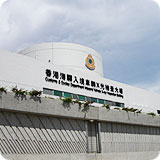 |
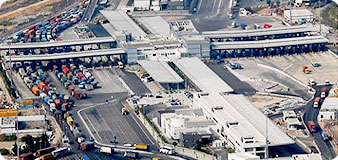 |
 |
 |
 |
 |
 Overview
of Lok Ma Chau Control Point after expansion. Overview
of Lok Ma Chau Control Point after expansion. |
|
 |
 |
 |
 |
|
 |
 |
 |
 |
 Vehicle
X-ray Inspection Building. Vehicle
X-ray Inspection Building. |
|
 |
 |
 |
 |
|
| 13. In order to facilitate
customs clearance of containerized cargo generated from
Container Terminal No. 9 at Tsing Yi, the department
has set up the Customs Tsing Yi Station which occupies
a site area of about 4 258m2 and comprises a two-storey
office block, a cargo examination compound and Customs
detector dog kennels. The construction works of the
last berth were completed in the 3rd quarter of 2004.
|
| |
 |
 |
 |
 |
 The
new cargo examination complex at Container
Terminal 9, Tsing Yi. The
new cargo examination complex at Container
Terminal 9, Tsing Yi. |
|
 |
 |
 |
 |
|
 |
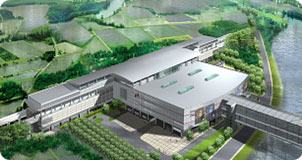 |
 |
 |
 |
 |
 The
panoramic view of the Sheung Shui to Lok Ma
Chau Spur Line Terminal. The
panoramic view of the Sheung Shui to Lok Ma
Chau Spur Line Terminal. |
|
 |
 |
 |
 |
|
| 14. An extension of
passenger railway stretching from Sheung Shui to a new
terminal at Lok Ma Chau will be constructed to address
the overcrowded condition at the Lo Wu Station. Customs
clearance facilities, including baggage examination
facilities, Customs offices, Customs detector dog kennels,
etc., will be set up at the Lok Ma Chau Terminus. The
construction works commenced at the end of 2002 and
are scheduled for completion in 2007. |
|
|
 |
|
 |
 |
|
 |
| |
Customs Equipment and
Facilities
17. On 11 March 2003, two sets of
fixed X-ray vehicle inspection system were inaugurated
at the Lok Ma Chau control point. This hi-tech equipment
enables Customs officers to view the content of a whole
container truck without opening the container. The inspection
time for each goods vehicle has been shortened greatly
from the previous three - four hours to less than 20
minutes. This has largely reduced the impact of cargo
inspection on the industry. Since the operation of the
two systems in 2003, officers at the control point have
detected a total of 79 smuggling cases involving seizures
valued at a total of $164.4 million, exceeding the system
cost of $113.8 million. With the enhancement of container
clearance efficiency, a win-win scenario between Customs
enforcement and trade facilitation was created. It signifies
a remarkable breakthrough of the Customs clearance methodology
and exemplifies the department’s forward looking
vision.
|
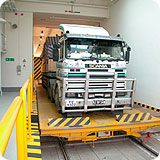 |
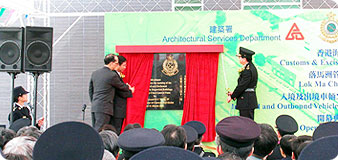 |
 |
 |
 |
 |
 Opening
ceremony officiated by Commissioner. Opening
ceremony officiated by Commissioner. |
|
 |
 |
 |
 |
|
 |
 |
 |
 |
 X-ray
scanning in progress. X-ray
scanning in progress. |
|
 |
 |
 |
 |
|
18. In April 2004, two more sets of mobile
X-ray vehicle scanning systems (MXRVS) were commissioned into
service. Among the four sets of MXRVS in total, two are located
at the Kwai Chung Container Terminals, while the other two at
Man Kam To control point and Sha Tau Kok control point respectively.
These systems can scan a whole container truck at a time and
officers can inspect the content of the container without unloading
the goods. The systems have made cargo clearance work more efficient
and cost-effective while enabling Customs to achieve trade facilitation
at the same time. 19. In March 2003,
Automatic Vehicle Recognition System was fully operative at
all the Customs kiosks at Lok Ma Chau, Man Kam To and Sha
Tau Kok control points. The system captures the registration
number of a passing vehicle, and inputs it into the Land Boundary
Systems (Customs computer system for vehicle clearance). It
saves a kiosk officer’s effort to key in the vehicle
number and thus reduces the average processing time of a vehicle
by three seconds.
 |
 |
 |
 |
 Cameras
for capturing vehicle image. Cameras
for capturing vehicle image. |
|
 |
 |
 |
 |
|
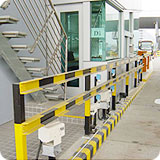 |
 |
 |
 |
 |
 |
 Recognised
vehicle number on screen. Recognised
vehicle number on screen. |
|
 |
 |
 |
 |
|
|
|
 |
|
 |
 |
|
 |
| |
 |
 |
 |
 |
 X-ray
baggage checker inside a search cubicle. X-ray
baggage checker inside a search cubicle. |
|
 |
 |
 |
 |
|
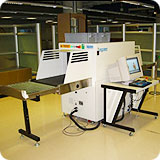 |
 |
 |
 |
 |
 |
 The
Control Room supports Customs officers to
monitor passenger flows at the arrival and
departure halls effectively and improve the
clearance service. The
Control Room supports Customs officers to
monitor passenger flows at the arrival and
departure halls effectively and improve the
clearance service. |
|
 |
 |
 |
 |
|
|
|
 |
|
 |
 |
|
 |
| |
SkyPier
24. The SkyPier, a cross boundary
ferry terminal to provide ferry services for transit
passengers between the Hong Kong International Airport
and other ports at the Pearl River Delta (PRD) of Mainland
China including Macau, commenced operation in September
2003. Ferry services between the Hong Kong International
Airport and four PRD ports, namely Macau, Tai Ping,
Shekou and Shenzhen were provided in the initial stage
and will be extended to other PRD ports. As the passengers
using the service are not required to undergo CIQ process
at the Hong Kong International Airport, the SkyPier
offers a speedy and seamless travel experience to passengers
plying between other countries and the PRD of Mainland
China. Transiting passengers and their baggage are transferred
between the Passenger Terminal Building (PTB) of the
Hong Kong International Airport and the SkyPier by sealed
buses along a dedicated and bonded road which is designated
as restricted area. In view of the security arrangement
so provided, Customs operations are conducted at the
SkyPier on a strike and search basis to facilitate trade
and tourism.
25. Since the commencement of operation
in September 2003, the daily passenger throughput of
SkyPier had picked up significantly by 267 percent for sea-to-air
passengers and 280 percent for air-to-sea passengers in December
2004. In view of the increasing demand for the services,
the SkyPier, apart from providing ferry services for
transit passengers between the Hong Kong International
Airport and the four PRD ports, has extended its services
to cover Zhongshan and Lianhuashan ports since December
2004.
|
| |
 |
|
|
 |
|
 |
 |
|
 |
| |
Legislation
26. Significant legislation affecting
the department enacted in 2003 and 2004 includes:-
(i) Import and Export (Facilitation) Bill –
to provide for the relaxation of import, export and
transportation control on nine categories of articles.
They include the removal of the licence requirement
for the import and export of left-hand drive vehicles
and outboard engines and export of prescribed articles
such as television sets, video cassette recorders, air
conditioners and refrigerators. For transshipment cargoes,
the licensing requirement for the import and export
of Optical Disc Mastering and Replication Equipment
has been replaced by a notification system.
(ii) Prevention of Child Pornography
Bill – to enact provisions prohibiting child
pornography, child sex tourism and pornographic performance
by children. The new enactment implements the requirements
of Article 34 of the United Nations Convention on the
Rights of the Child.
(iii) Chemical Weapons (Convention)
Bill – to enact provisions in banning the
development, production, stockpiling and use of chemical
weapons. The new enactment implements the requirement
of an international treaty called the "Convention on
the Prohibition of the Development, Production, Stockpiling
and Use of Chemical Weapons and on their Destruction".
(iv) Import and Export (General)
(Amendment) Regulation – to amend the Seventh
Schedule of the Import and Export (General) Regulation
(Cap. 60 sub. leg. A) for the purpose of implementing
in Hong Kong an international certification scheme for
rough diamonds known as the Kimberly Process Certificate
Scheme. The scheme aims to stop trading in rough diamonds
used by rebel movements or their allies to finance armed
conflicts, activities of rebel movements and illicit
proliferation of armament.
(v) Broadcasting (Amendment) Bill
– to amend the Broadcasting Ordinance
(Cap.562) and to make it an offence to possess
or use or authorize another person to possess or use
an unauthorized decoder for commercial purposes. The
enactment of this amendment ordinance on 7 July 2004
empowers the department to enforce import and export
control on unauthorized decoders at the control points.
|
| |
 |
|
|
 |
|
 |
|
|

